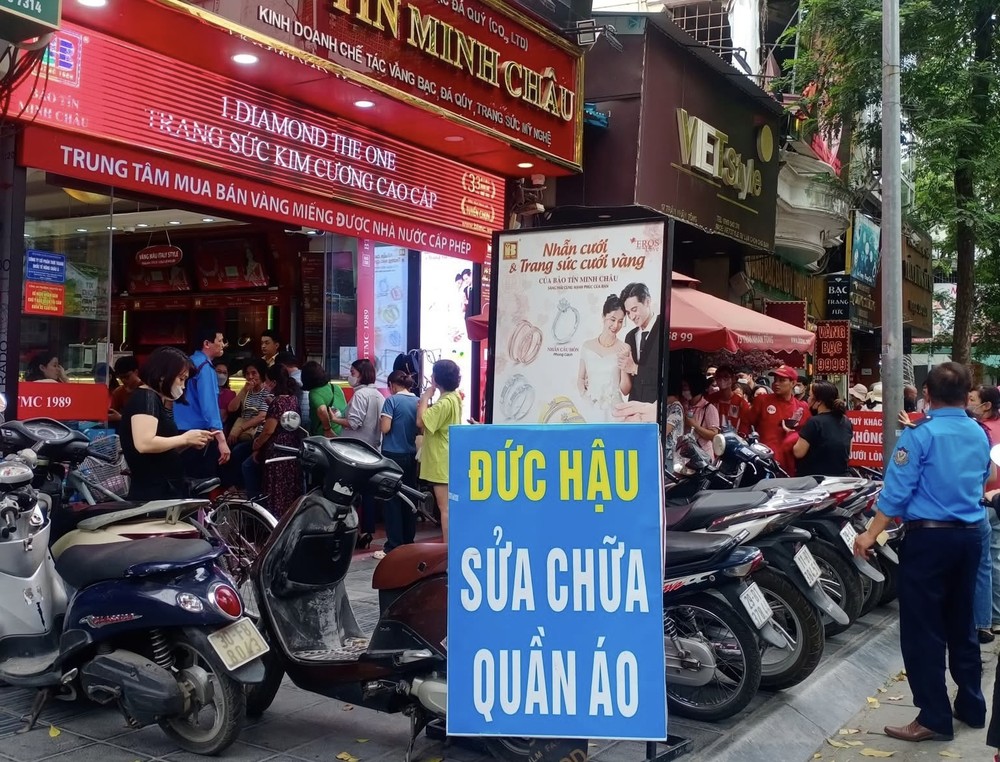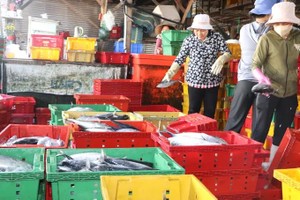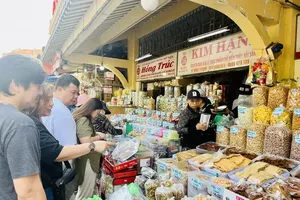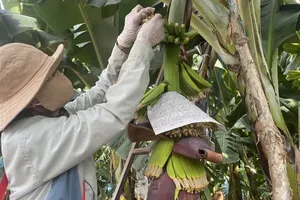Over the past weekend, domestic gold prices in Vietnam plunged by as much as VND6 million per tael, only to rebound sharply at the start of the week. The sudden surge in demand led to a significant supply-demand imbalance. Many gold stores were unable to meet the demand and had to issue promissory notes to customers.
Shuttered stores, empty stocks, and drip sales
According to SGGP's correspondent, global gold prices surged again following the Easter weekend on April 21. By 4:30 p.m., prices briefly surpassed US$3,390 an ounce.

Earlier that day at 9 a.m. in Hanoi, many gold retailers simultaneously adjusted their prices after two days of steep declines. Reports noted that the price of Hung Thinh Vuong plain gold rings from Doji (DOJI Gold & Gems Group) rose from VND11.35 million per mace on April 20 to VND11.6 million per mace, and within minutes, climbed further to VND11.7 million per mace.
Around the same time, Bao Tin Minh Chau and Bao Tin Manh Hai also raised their quoted prices from VND11.5 million per mace to VND11.7 million and then VND11.8 million per mace, respectively.
Despite the soaring prices, Tran Nhan Tong Street—known as Hanoi’s “gold street” in Hai Ba Trung District—was bustling with activity from early morning. Bao Tin Minh Chau's two branches remained packed with long queues stretching from morning through midday and early afternoon on April 21. Buyers far outnumbered sellers.
Meanwhile, shops like Bao Tin Manh Hai and Saigon Jewelry Company (SJC) saw fewer customers, but they all faced a common issue: little to no gold left for sale. By 11 a.m., SJC staff said only 0.5-mace rings were still available. By afternoon, the shortage persisted, with many customers walking in only to leave empty-handed.

At Bao Tin Manh Hai, although customer volume was slightly higher than at Doji or SJC, the store had already run out of 9999 gold, leaving only limited quantities of jewelry-grade gold, which saw little interest. Moreover, the store could no longer deliver 24K gold on the spot and instead had to issue purchase receipts—even after full payment. Customers were given pickup dates 15 to 20 days later.
That same morning, the shop temporarily closed before reopening around 1 p.m.
Doji’s outlets on Tran Nhan Tong (Hai Ba Trung District) and Quang Trung Street (Ha Dong District) were also consistently out of stock and unable to sell directly over the counter.
Most buyers had to place orders via the company’s mobile application, which frequently showed that purchase limits had been reached. Many customers said it was extremely difficult to secure gold through Doji’s application.
At Bao Tin Minh Chau, customers were limited to purchasing a maximum of two maces of gold each. Priority was given to those who arrived before 10:30 a.m., and after that time, no new customers were admitted due to overwhelming demand. Similarly, the Phu Quy branch posted a “sold out” sign at 10:30 a.m. on April 21, leaving many empty-handed or scrambling to find alternative brands.

Buyers need to stay cautious
Experts warn that although domestic gold prices on April 21 have shown signs of cooling down from the peak on April 18, the gap between local and global gold prices remains unusually high.
Specifically, based on the current exchange rate, the global gold price converted to Vietnamese dong is approximately VND106.6 million per tael, or about VND10.66 million per mace. Meanwhile, domestic gold ring prices continue to fluctuate around VND11.7 - 11.8 million per mace, resulting in a price difference of approximately VND11 - 12 million per tael between local and global prices.
Experts advise that investors remain cautious, as times when the market is unusually "heated" are often the riskiest.
























